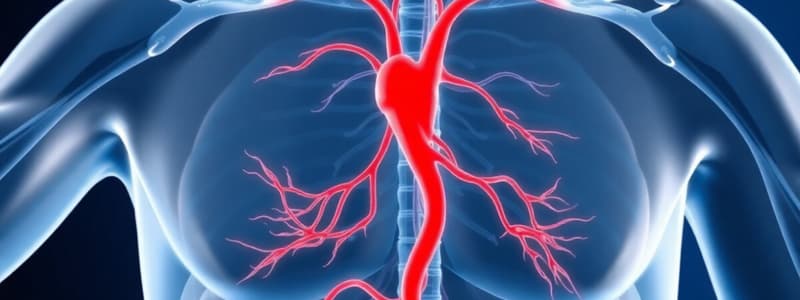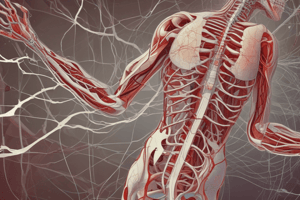Podcast
Questions and Answers
What is the most important autonomic influence on cutaneous blood flow?
What is the most important autonomic influence on cutaneous blood flow?
- Vasodilation via Parasympathetics
- No significant influence
- Local control
- Vasoconstriction via Sympathetics (correct)
In skeletal muscle, what overrides sympathetic control during exercise?
In skeletal muscle, what overrides sympathetic control during exercise?
- Hormonal control
- Sympathetic control
- Local control (correct)
- Autoregulation
Sympathetic influence is very important for coronary blood flow.
Sympathetic influence is very important for coronary blood flow.
False (B)
What mechanisms primarily regulate blood flow in the cerebral region?
What mechanisms primarily regulate blood flow in the cerebral region?
The unique feature of pulmonary regulation is that hypoxia causes __________.
The unique feature of pulmonary regulation is that hypoxia causes __________.
Which of the following statements is true regarding coronary blood flow?
Which of the following statements is true regarding coronary blood flow?
Total Peripheral Resistance (TPR) changes significantly during static exercise.
Total Peripheral Resistance (TPR) changes significantly during static exercise.
What are the mechanical factors affecting blood flow in skeletal muscle?
What are the mechanical factors affecting blood flow in skeletal muscle?
Which region of the body has the most important autonomic influence from vasoconstriction via sympathhetics?
Which region of the body has the most important autonomic influence from vasoconstriction via sympathhetics?
In which region is local control most important during exercise?
In which region is local control most important during exercise?
Sympathetic autonomic influence is the most important for coronary blood flow.
Sympathetic autonomic influence is the most important for coronary blood flow.
What is the unique feature of the pulmonary region's local control?
What is the unique feature of the pulmonary region's local control?
What does TPR stand for?
What does TPR stand for?
Flow in the cerebral region is determined by __________.
Flow in the cerebral region is determined by __________.
Flashcards
Autonomic control of blood flow
Autonomic control of blood flow
Regulation of blood flow to different tissues by the autonomic nervous system (primarily sympathetic).
Local control of blood flow
Local control of blood flow
Regulation of blood flow in specific organ systems, like heart and brain, based on local conditions.
Cutaneous blood flow
Cutaneous blood flow
Blood flow to the skin.
Sympathetic vasoconstriction
Sympathetic vasoconstriction
Signup and view all the flashcards
Skeletal muscle blood flow
Skeletal muscle blood flow
Signup and view all the flashcards
Metabolic hyperemia
Metabolic hyperemia
Signup and view all the flashcards
Coronary blood flow
Coronary blood flow
Signup and view all the flashcards
Autoregulation
Autoregulation
Signup and view all the flashcards
Myogenic response
Myogenic response
Signup and view all the flashcards
Cerebral blood flow
Cerebral blood flow
Signup and view all the flashcards
Pulmonary blood flow
Pulmonary blood flow
Signup and view all the flashcards
Dynamic exercise (Active Hyperemia)
Dynamic exercise (Active Hyperemia)
Signup and view all the flashcards
Static exercise (Reactive Hyperemia)
Static exercise (Reactive Hyperemia)
Signup and view all the flashcards
Diastole
Diastole
Signup and view all the flashcards
Systole
Systole
Signup and view all the flashcards
Intracranial Pressure
Intracranial Pressure
Signup and view all the flashcards
Hypoxia
Hypoxia
Signup and view all the flashcards
Vasoconstriction
Vasoconstriction
Signup and view all the flashcards
Vasodilation
Vasodilation
Signup and view all the flashcards
Total Peripheral Resistance (TPR)
Total Peripheral Resistance (TPR)
Signup and view all the flashcards
Myocardium
Myocardium
Signup and view all the flashcards
Basal Perfusion
Basal Perfusion
Signup and view all the flashcards
Sympathetic Nervous System
Sympathetic Nervous System
Signup and view all the flashcards
Study Notes
Autonomic and Local Control of Blood Flow
- Autonomic nervous system plays a significant role in regulating blood flow to various parts of the body, particularly for cutaneous (skin) and skeletal muscle blood flow.
- Local control mechanisms are primarily responsible for regulating blood flow in organs like the coronary (heart) and cerebral (brain) systems.
- Cutaneous blood flow is mainly controlled by sympathetic vasoconstriction.
- Sympathetic nervous system is the most important factor in regulating skeletal muscle blood flow at rest.
- During exercise, local control mechanisms take over, overriding sympathetic influence. This is known as metabolic hyperemia, as it involves increased blood flow to meet metabolic demands.
- Coronary blood flow is primarily regulated by autoregulation, driven by the myogenic response and metabolic hyperemia. Local control is crucial for ensuring sufficient oxygen delivery to the heart.
- Cerebral blood flow is heavily dependent on autoregulation, which is primarily influenced by the myogenic response and metabolic hyperemia.
- Pulmonary blood flow, unlike other regions, exhibits vasoconstriction in response to hypoxia (low oxygen levels).
- Mechanical factors also play a role in regulating blood flow. For example, skeletal muscle blood flow is influenced by the type of exercise – dynamic exercise causes active hyperemia, while static exercise leads to reactive hyperemia.
- Coronary blood flow is affected by the mechanical compression of vessels during systole, resulting in lower blood flow during this phase.
- Cerebral blood flow is directly impacted by intracranial pressures. High pressures can lead to compression of blood vessels and restrict blood flow, as seen in cases like brain injuries and tumors.
Autonomic and Local Control of Blood Flow
- Cutaneous Blood Flow:
- Sympathetic nervous system plays a dominant role in vasoconstriction.
- Local control mechanisms are relatively weak, including autoregulation and reactive hyperemia.
- Skeletal Muscle Blood Flow:
- Sympathetics are most important at rest, maintaining basal perfusion.
- During exercise, local control mechanisms (metabolic hyperemia) override sympathetic influences, ensuring adequate oxygen delivery to active muscles.
- Dynamic exercise leads to active hyperemia, characterized by decreased total peripheral resistance (TPR).
- Static exercise triggers reactive hyperemia, but with minimal impact on TPR.
- Coronary Blood Flow:
- Sympathetic influence is minimal.
- Local control is crucial due to the oxygen-dependent nature of cardiac function.
- Autoregulation via myogenic responses and metabolic hyperemia are paramount.
- The majority of blood flow occurs during diastole, with compression of coronary vessels during systole limiting blood flow.
- Cerebral Blood Flow:
- Sympathetic contribution is minimal.
- Autoregulation via myogenic response and metabolic hyperemia are critical for maintaining consistent brain blood flow.
- Intracranial pressure significantly alters cerebral blood flow. High pressure can compress blood vessels, hindering flow.
- This occurs in conditions like brain injury and tumors.
- Pulmonary Blood Flow:
- Sympathetic control is insignificant.
- Local control mechanisms are dominant.
- Hypoxia, a decrease in oxygen levels, triggers vasoconstriction in the pulmonary circulation.
- This mechanism is critical in pulmonary gas exchange.
Studying That Suits You
Use AI to generate personalized quizzes and flashcards to suit your learning preferences.



